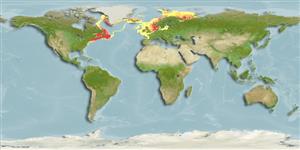Actinopterygii (ray-finned fishes) >
Perciformes (Perch-likes) >
Anarhichadidae (Wolffishes)
Etymology: Anarhichas: Greek, anarhichaomai = to climb up. More on author: Linnaeus.
Environment / Climate / Range
Ecology
Marine; demersal; oceanodromous (Ref. 51243); depth range 1 - 600 m (Ref. 58426), usually 18 - 110 m (Ref. 7135). Temperate, preferred 9°C (Ref. 107945); 79°N - 37°N, 75°W - 56°E (Ref. 54281)
Northeast Atlantic: Spitsbergen southward to White Sea, Scandinavian coasts, North Sea, the British Isles, also Iceland and south-eastern coasts of Greenland. Northwest Atlantic: southern Labrador in Canada and western Greenland to Cape Cod in Massachusetts, USA; rarely to New Jersey, USA (Ref. 7251). Elsewhere in the Baltic Sea (east to Rügen and Bornholm Islands), Bay of Biscay and northwestern Mediterranean (Gulf of Genoa) (Ref. 57932).
Length at first maturity / Size / Weight / Age
Maturity: Lm ?, range 50 - 60 cm
Max length : 150 cm TL male/unsexed; (Ref. 7251); max. published weight: 23.6 kg (Ref. 40637)
Ground color usually greyish-green but almost black or reddish -brown. Body with 10-15 transverse, dark bars extended to the dorsal fin (Ref. 35388).
Inhabit rocky bottoms, sometimes over sand or mud, from 1-500 m (Ref. 9988). Benthic (Ref. 58426). Feeds on fishes (Ref. 58426), hard-shelled mollusks, crabs, lobsters, sea urchins and other echinoderms. Solitary in habit (Ref. 9988). Marketed fresh and frozen; eaten steamed, fried, broiled, boiled, microwaved and baked (Ref. 9988).
Males guard a clutch of eggs right up to the time of hatching (Ref. 6407). During brood protection, the male hardly feeds (Ref. 6407).
Barsukov, V.V., 1986. Anarhichadidae. p. 1113-1116. In P.J.P. Whitehead, M.-L. Bauchot, J.-C. Hureau, J. Nielsen and E. Tortonese (eds.) Fishes of the North-eastern Atlantic and the Mediterranean. volume 3. UNESCO, Paris. (Ref. 4694)
IUCN Red List Status (Ref. 115185)
CITES (Ref. 94142)
Not Evaluated
Threat to humans
Harmless
Human uses
Fisheries: highly commercial; aquaculture: experimental; gamefish: yes; aquarium: public aquariums
More information
ReferencesAquacultureAquaculture profileStrainsGeneticsAllele frequenciesHeritabilityDiseasesProcessingMass conversion
Tools
Special reports
Download XML
Internet sources
